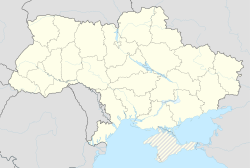Bohorodchany
|
Bohorodchany Богородчани |
|
|---|---|
| Town | |

Dominican monastery in Bohorodchany
|
|
| Location of Bohorodchany, Ukraine | |
| Coordinates: 48°48′29″N 24°32′17″E / 48.80806°N 24.53806°ECoordinates: 48°48′29″N 24°32′17″E / 48.80806°N 24.53806°E | |
| Country | Ukraine |
| Oblast | Ivano-Frankivsk Oblast |
| Raion | Bohorodchany Raion |
| Area | |
| • Total | 12 km2 (5 sq mi) |
| Population (2016) | |
| • Total | 7,971 |
| • Density | 631.08/km2 (1,634.5/sq mi) |
| Area code(s) | +380 3471 |
Bohorodchany (Ukrainian: Богородчани, pronounced [ˈboɦorodtʂanɪ]; Polish: Bohorodczany) is an urban-type settlement in Ivano-Frankivsk Oblast, several miles from Ivano-Frankivsk. It is the administrative center of Bohorodchany Raion. Population: 7,971 (2016 est.).
It is not known when the town was established, but it was first mentioned in 1441 as a property of certain Jan of Buczacz, the starost of Trembowla (today Terebovlia). Since the second half of the 15th century the local estate belonged to the . In 1691 , widow of the owner of the village , established a Roman Catholic church and a parish there. In 1742 the wooden church was replaced with a more permanent construction, founded by Stanisław Kossakowski and devoted to the cult of Holy Mary. In 1765 the new church was donated to the Dominican Order, whose friars established a convent there.
Later in the 18th century the town's area acted as a base for a local band of outlaws led by Oleksa Dovbush, a semi-legendary Hutsul folk hero, who according to a local legend took the town by force in 1744. In 1786 the town had 314 permanent buildings and 1134 inhabitants.
Following the Partitions of Poland the town became part of the Habsburg Empire and then Austria-Hungary. In the 19th century the town was a scene of intense social and economic activities by all three major groups of inhabitants - Jews, Ukrainians and Poles. Already in 1770 a Polish language grammar school was established, followed by a Jewish Hertz Homberg school in 1785 and a state-sponsored German language grammar school in 1789. In 1848 a local branch of a Russka Rada (Ruthenian Council) was established by 29 local Ukrainians. Around the same time numerous Jewish social and educational facilities were established, including a Hebrew School of the Union of Hebrew Teachers of Austria (1908-1914), a local branch of Ezrat Israel zionist union (1896), a Torat Haim yeshiva (1908) and a grammar school for girls (1909). By the end of the 19th century the town grew to 4597 inhabitants, including 2009 Jews, 1788 Greek Catholics and 800 Roman Catholics. The largest estates in the surrounding area belonged to Count Rudolf Stadion.
...
Wikipedia

